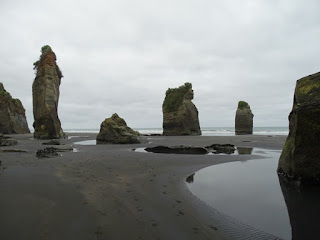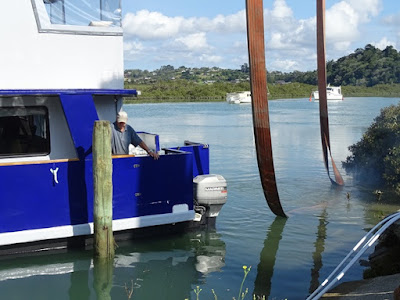This is the Joan Maree — she belongs to our friends Al and Karen who live on board, moored in the Fairway Bay Marina where we're based at the moment. Al and Karen built this houseboat themselves and recently had her lifted out of the water so they could do some more work on the underneath. When the additions and maintenance were completed, we agreed to help them on the day they'd chosen to get her back into the water. Well, Dave did ... I just recorded the events!
Disclaimer: If I use the wrong terminology, please forgive me ... I'm not a boatie or a crane driver!
We were up reasonably early that morning. Alan and Karen had driven their vehicles to the marina and we gave them a lift back down the road — about 15-20 minutes — to the boatyard. Mark (another marina neighbour) turned up as well. It was a stunning, calm morning ... the tide was well in and the water was like glass.

There she was ... sitting up on blocks with a shiny new black bottom with some modifications. There are three 'keels' under the Joan Maree
— they're easier to see in some of the following photos. The outside two were widened and the middle one extended in the hope that she'd ride higher in the water.
The crane that was going to lift her back into the water was alongside, waiting for the driver to arrive.
The front windscreen of this crane truck looks like it's seen better days ... hmm.
Some last-minute things to sort out on board. These steps were what they'd used to get on and off the houseboat over the previous weeks.
Another view of the crane truck, this one showing the wheels off the ground; it has stabilisers — one shows in the right foreground of this pic; they're more obvious in other photos. Note the wide straps lying on the ground to the left; these are the slings to go under the houseboat.
Then the crane driver, Tim, arrived.
Action!
Trust me — I know what I'm doing ...
(I'm remembering the windscreen.)
Tim manoeuvred this big hook over to where some straps were lying on the ground, attached to a sort of girder. Tim and Alan attached them to the big hook while Mark watched.
The girder was lifted up and swung across the Joan Maree, with another pair of straps dangling down at each end.
This girder had to be positioned dead centre over the Joan Maree. Tim climbed out of the crane a few times to see what was happening on the other side and to line things up.
The ends of the straps were attached to the two slings that were lying on the ground under the houseboat.
And up she went ... very slowly.
Tim instructing Mark on how he wants things to be done. The entire procedure from when Tim arrived to when the Joan Maree was in the water took over an hour.
Out over the water ...
It needs to be swung out over and past that post sticking up out of the water.
Down she comes, just missing the post.
She settled on the water so slowly and carefully, there wasn't even a ripple. I guess Tim does know what he's doing! And success! She rides higher in the water than she used to.
All aboard with the final bits and pieces...
... floating the slings off the back end.
Ropes untied, pushing her away from that post ...
There she goes!
Down the river, around the bend and out of sight. My task was to drive our vehicle back home to the marina and wait for them to arrive. They stopped to do some fishing along the way ... fish for tea — yay!
Arriving back at the marina.
There's been a bit of movement since they've been away and now they need to nestle in between two big catamarans. That gap looks rather small! You can see the left back of one of the catamarans off to the right, and the front of the other is just peeking out in front of the houseboat.
She nosed in first ... ropes were thrown to helpers ashore to help pull her around ...
... and there she is. Welcome home, guys!




































































